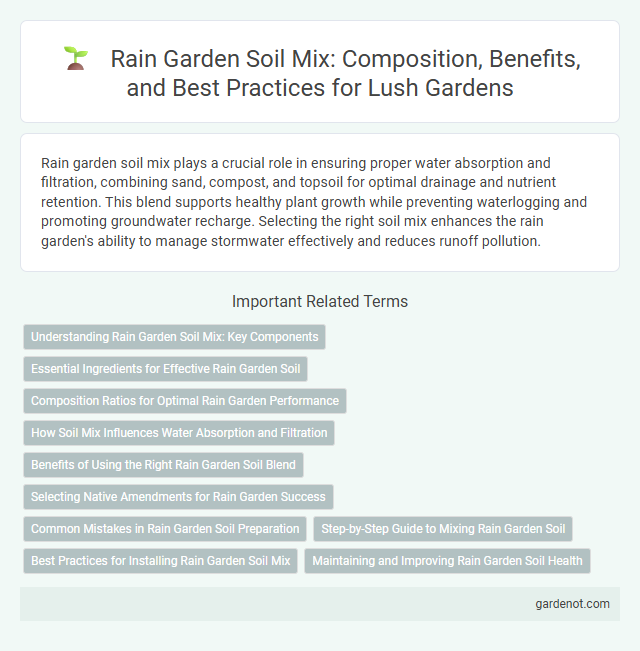Rain garden soil mix plays a crucial role in ensuring proper water absorption and filtration, combining sand, compost, and topsoil for optimal drainage and nutrient retention. This blend supports healthy plant growth while preventing waterlogging and promoting groundwater recharge. Selecting the right soil mix enhances the rain garden's ability to manage stormwater effectively and reduces runoff pollution.
Understanding Rain Garden Soil Mix: Key Components
Rain garden soil mix typically consists of a balanced blend of sand, compost, and topsoil to ensure optimal drainage and nutrient retention. High-quality compost enriches the soil with organic matter, promoting healthy plant growth and microbial activity. Properly proportioned sand improves infiltration rates, preventing waterlogging while allowing excess rainwater to percolate efficiently into the ground.
Essential Ingredients for Effective Rain Garden Soil
An effective rain garden soil mix contains a balanced blend of sand, compost, and topsoil, ensuring optimal drainage and nutrient retention. A typical ratio includes 50-60% sand to promote infiltration, 20-30% compost for organic matter and microbial activity, and 20-30% topsoil to support plant growth and structure. This specialized soil composition maximizes water absorption, reduces runoff, and supports healthy vegetation in rain garden installations.
Composition Ratios for Optimal Rain Garden Performance
Rain garden soil mix typically consists of 50-60% sand, 20-30% compost, and 20-30% topsoil to ensure proper drainage and nutrient retention. This composition ratio enhances water infiltration while supporting plant growth and microbial activity. Balancing these components is critical for achieving optimal rain garden performance and preventing waterlogging or soil compaction.
How Soil Mix Influences Water Absorption and Filtration
Rain garden soil mix significantly influences water absorption and filtration by balancing sand, compost, and topsoil to optimize permeability and nutrient retention. Well-structured soil with high organic content enhances microbial activity, promoting pollutant breakdown and improving water quality before it reaches groundwater. Properly engineered soil mix prevents runoff, increases infiltration rates, and supports healthy plant growth for effective stormwater management.
Benefits of Using the Right Rain Garden Soil Blend
Using the right rain garden soil blend enhances water infiltration and reduces runoff, promoting efficient stormwater management. A well-balanced soil mix rich in organic matter and sand ensures optimal drainage and nutrient retention, supporting healthy plant growth. Proper soil composition also minimizes erosion and helps filter pollutants, improving overall water quality in the surrounding environment.
Selecting Native Amendments for Rain Garden Success
Selecting native amendments for rain garden soil mix enhances permeability and nutrient retention, promoting healthy plant growth and effective stormwater management. Incorporating locally sourced compost, sand, and organic matter tailored to native soil characteristics supports microbial activity and water infiltration. These native amendments create a balanced soil environment that sustains rain garden functionality and resilience.
Common Mistakes in Rain Garden Soil Preparation
Common mistakes in rain garden soil preparation include using heavy clay soil that impedes water infiltration and failing to incorporate enough organic matter, which reduces permeability and nutrient retention. Overlooking soil texture balance can lead to poor drainage, causing standing water and plant stress. Properly blending sand, compost, and topsoil ensures optimal water absorption and supports healthy plant growth in rain gardens.
Step-by-Step Guide to Mixing Rain Garden Soil
Begin by combining 50% sand to promote drainage, 25% compost to enhance nutrient content, and 25% topsoil to provide structure and support plant growth. Thoroughly blend these components to ensure even distribution of materials, which is essential for effective water infiltration and root development. Carefully test the mixture's texture and moisture retention capacity before planting, aiming for a loose, well-draining soil that mimics natural wetland conditions.
Best Practices for Installing Rain Garden Soil Mix
Rain garden soil mix should consist of 40-60% sand, 20-40% topsoil, and 20-30% compost to ensure proper drainage and nutrient retention. Incorporating well-draining materials prevents waterlogging while organic matter enhances microbial activity and plant health. Testing soil infiltration rates before installation guarantees that the mix supports effective stormwater management and plant growth.
Maintaining and Improving Rain Garden Soil Health
Maintaining rain garden soil health involves regularly incorporating organic matter such as compost to enhance nutrient content and microbial activity. Improving soil structure through periodic aeration supports water infiltration and root growth, vital for effective stormwater management. Monitoring soil pH and nutrient levels ensures optimal conditions for native plant species that thrive in rain garden environments.
Rain garden soil mix Infographic

 gardenot.com
gardenot.com